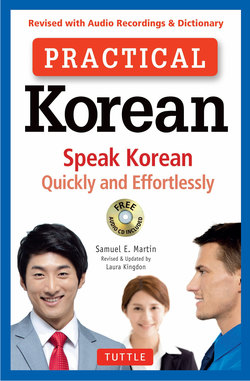Читать книгу Practical Korean - Samuel E. Martin - Страница 19
На сайте Литреса книга снята с продажи.
ОглавлениеLESSON 12
Particles
A PARTICLE is a little word which shows the relationship between the word or phrase preceding it and the rest of the sentence. Some Korean particles are similar in function to English prepositions (in, on, at, from, till, of); others indicate grammatical relationships which English shows by word order—like subject and object.
In English it makes a difference whether we say The cat eats the bird or The bird eats the cat. In practice, the subject is almost always first, followed by the object and then the verb; however, things can be switched around freely to show emphasis, especially in longer sentences.
The order in which we put the two nouns is determined by EMPHASIS rather than by which one does the eating. In order to make it clear which is the SUBJECT (which one eats) and which is the OBJECT (which one gets eaten), Korean uses different particles:
Goyangi-ga sae-reul meogeoyo and Sae-reul goyangi-ga meogeoyo both mean The cat eats the bird. Sae-ga goyangi-reul meogeoyo and also Goyangi-reul sae-ga meogeoyo both mean The bird eats the cat.
One characteristic of a particle is that you practically never pause in front of it—it’s always linked with the preceding word.
There are TWO-SHAPE particles and ONE-SHAPE particles. The one-shape particles always look the same, regardless of the word they follow. The two-shape particles have different shapes depending on the shape of the preceding word.
In many cases, particles will have a single syllable after a noun, but after a consonant, an extra 으 (eu) will be added first. See the last example below. This also happens very often with verb endings.
| MEANING OF PARTICLE | SHAPE AFTER CONSONANT | SHAPE AFTER VOWEL |
| subject | i | ga |
| object | eul | reul |
| “with, and” | gwa | wa |
| “or, and” | ina | na |
| “hey!, Oh!” (vocative) | a | ya |
| through, to | euro | ro |
Here are some examples with words of the preceding lessons:
| PARTICLE | AFTER CONSONANT | AFTER VOWEL |
| subject | ireum-i | dambae-ga |
| 이름이 | 담배가 | |
| bang-i | nai-ga | |
| 방이 | 나이가 | |
| mul-i (mu-ri) | binu-ga | |
| 물이 | 비누가 | |
| object | yangmal-eul | gudu-reul |
| 양말을 | 구두를 | |
| sinmun-eul | jongi-reul | |
| 신문을 | 종이를 | |
| sangjeom-eul | hakgyo-reul | |
| 상점을 | 학교를 | |
| “with, and” | hyeong-gwa* | na wa |
| 형과 | 나와 | |
| gajok-gwa* | chingu-wa | |
| 가족과 | 친구와 | |
| Iut-gwa* | nongbu-wa | |
| 이웃과 | 농부와 | |
| “or, and, or the like” | sugeon-ina | baj-ina |
| 수건이나 | 바지나 | |
| through, to | gonghang-euro | hakkyo-ro |
| 공항으로 | 학교로 | |
| jip-euro | keompyuteoro | |
| 집으로 | 컴퓨터로 | |
| chaeksang-ina | moja-na | |
| 책상이나 | 모자나 | |
| vocative | Gim seonsaeng! | Gim moksa! |
| 김 선생 | 김 목사 | |
| (Oh, Mr. Kim!) | (Oh, Reverend Kim!) | |
| Gildong a! | Yeongsu ya! | |
| 길동아 | 영수야 | |
| (Hey, Poktong!) | (Hey, Haksu!) |
* Don’t forget k sounds like g between voiced sounds.
NOTE: Before the subject particle, the following nouns have different shapes:
| na | I | 나 | nae-ga | 내가 |
| jeo | I (formal) | 저 | je-ga | 제가 |
| nugu | who | 누구 | nu-ga | 누가 |
